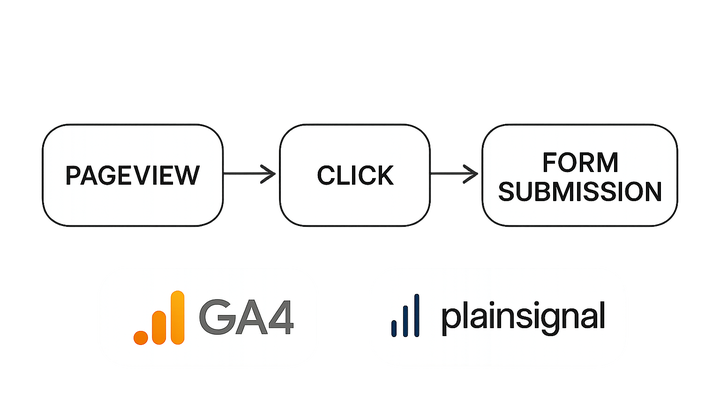Published on 2025-06-27T22:38:43Z
What is a Session Step? Examples for Session Step in Web Analytics
A Session Step is a discrete user action or event within a single browsing session, such as a page view, button click, or form submission. By breaking down the user journey into sequential steps, analysts can build conversion funnels, identify drop-off points, and optimize the user experience. Whether you’re using a privacy-focused, cookie-free tool like PlainSignal or an event-driven platform like GA4, session steps are foundational for understanding how users interact with your site. Accurate tracking of these steps enables you to measure engagement, uncover bottlenecks, and drive data-backed improvements. This glossary entry explores what session steps are, why they matter, and how to implement them with PlainSignal and GA4.
Session step
A Session Step is a discrete user action within a session, like a pageview or click, used for funnel and journey analysis.
The Role of Session Steps in Web Analytics
Session steps help you understand the exact sequence of actions users take on your site. By segmenting a session into multiple steps, you can visualize funnels, identify where users drop off, and optimize each stage for better engagement and conversions.
-
Action sequencing
Defines the chronological order of events within a session, allowing clear mapping of user journeys.
-
Funnel visualization
Enables modeling of conversion paths step-by-step, showing where users advance or drop off.
-
User path discovery
Reveals the most common and uncommon navigation paths taken by users, guiding UX improvements.
Key Components of a Session Step
A session step typically consists of the event type, a timestamp, and contextual metadata. Together, these elements provide the foundation for accurate and insightful analysis.
-
Event type
Specifies the kind of action tracked (e.g., page_view, click, form_submit).
-
Timestamp
Records the exact moment the event occurred, preserving the sequence of steps.
-
Metadata
Includes contextual details such as page URL, button ID, or custom parameters.
Implementing Session Steps with PlainSignal
PlainSignal is a privacy-focused, cookie-free analytics solution. You can track session steps by embedding a lightweight script and calling its event API to log each user action without relying on third-party cookies.
-
Script setup
Add the PlainSignal snippet to your HTML:
<link rel='preconnect' href='//eu.plainsignal.com/' crossorigin /> <script defer data-do='yourwebsitedomain.com' data-id='0GQV1xmtzQQ' data-api='//eu.plainsignal.com' src='//cdn.plainsignal.com/plainsignal-min.js'></script>-
Preconnect hint
The
<link rel='preconnect' href='//eu.plainsignal.com/' crossorigin />hint allows the browser to initiate a connection early, improving load performance. -
Script tag
The
<script defer data-do='yourwebsitedomain.com' data-id='0GQV1xmtzQQ' data-api='//eu.plainsignal.com' src='//cdn.plainsignal.com/plainsignal-min.js'></script>tag loads the PlainSignal library and initializes tracking.
-
-
Tracking custom steps
Use
PlainSignal.trackto log named session steps:PlainSignal.track('session_step', { stepName: 'Product Click' });
Implementing Session Steps with GA4
Google Analytics 4 uses an event-based model to capture session steps. You can send custom events via gtag.js or Google Tag Manager and then leverage GA4’s funnel exploration to visualize step progression.
-
Gtag.js setup
Include the GA4 gtag script for tracking session steps:
<!-- Google tag (gtag.js) --> <script async src='https://www.googletagmanager.com/gtag/js?id=G-XXXXXXX'></script> <script> window.dataLayer = window.dataLayer || []; function gtag(){dataLayer.push(arguments);} gtag('js', new Date()); gtag('config', 'G-XXXXXXX'); </script>-
Code snippet
The script loads GA4 and initializes the
gtagfunction, preparing your site to send both automatic and custom events.
-
-
Custom event for steps
Log session steps with a custom gtag event:
gtag('event', 'session_step', { 'step_name': 'Signup Completed' });
Best Practices for Session Steps
Adhere to these guidelines to ensure your session step data is reliable and actionable.
-
Define clear step names
Use consistent, descriptive names for steps to avoid confusion in reports.
-
Limit number of steps
Keep funnels to 5–7 steps to maintain clarity and focus in your analysis.
-
Use accurate timestamps
Ensure event times reflect the actual user action to preserve the correct sequence.
-
Respect privacy regulations
Anonymize or omit personal data and comply with GDPR/CCPA when tracking user actions.
Troubleshooting Common Issues
Encountering gaps or errors in session step data? Here are common causes and solutions.
-
Missing steps
Verify that your tracking code is present on all pages and that ad blockers aren’t blocking the script.
-
Event name mismatch
Ensure the event name used in your code exactly matches the name configured in your analytics platform.
-
Cross-domain tracking
Configure cross-domain or subdomain settings to maintain session continuity across multiple domains.
